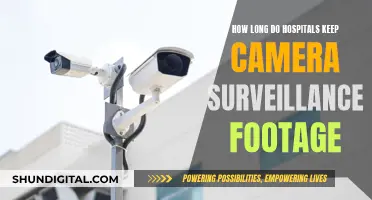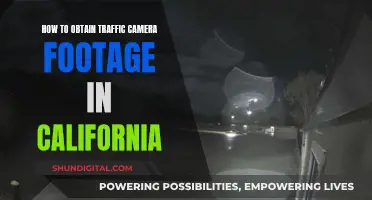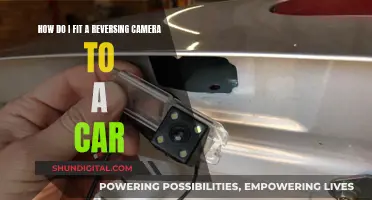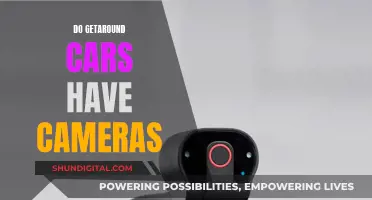
The autofocus system in a camera is an intelligent feature that adjusts the camera lens to obtain focus on the subject, ensuring a sharp photo. There are two main types of autofocus (AF) systems: Active AF and Passive AF. Active AF systems use ultrasonic or infrared signals to determine the distance to the subject by calculating the time it takes for the signal to reflect back to the camera. On the other hand, Passive AF systems use either contrast detection or phase detection methods. Contrast detection measures the intensity of light on pixels and adjusts the lens to maximise sharpness. Phase detection divides the incoming light into pairs of images and compares them to evaluate the positional relationship, adjusting the lens until the two images match. Modern cameras offer various AF modes, such as One Shot AF for still subjects and AI Servo AF for moving subjects, allowing photographers to capture sharp images in different scenarios.
| Characteristics | Values |
|---|---|
| Camera autofocus system | Intelligently adjusts the camera lens to obtain focus on the subject |
| Passive AF | Uses contrast sensors within the camera |
| Active AF | Emits a signal to illuminate or estimate the distance to the subject |
| Passive AF methods | Contrast detection, phase detection |
| Active AF method | AF assist beam |
| Autofocus sensor | The real engine behind achieving accurate focus |
| Autofocus processor (AFP) | Makes a small change in the focusing distance |
| AF mode | Continuous & AI Servo, one shot |
| AF assist beam | A method of active autofocus that uses a visible or infrared beam to help the autofocus sensors detect the subject |
| Phase detection | Used by most DSLR cameras; relies on a "phase-detect" autofocus sensor located inside the camera |
| Contrast detection | Used by mirrorless cameras, point-and-shoot cameras, DSLR cameras in live view, and smartphone cameras |
What You'll Learn

Active vs Passive autofocus systems
There are two main types of autofocus systems: active and passive. Some cameras may have a combination of both types, depending on the price of the camera. In general, less expensive point-and-shoot cameras use an active system, while more expensive SLR (single-lens reflex) cameras with interchangeable lenses use the passive system.
Active autofocus systems
Active autofocus systems use a laser or infrared beam to measure the distance to the subject. Active systems irradiate light from a dedicated autofocus light source onto the subject and focus based on the returned light. This technique is used for advanced inspection systems where the sample lacks contrast, such as flat panel and bare wafer inspection systems. Active systems work in the dark, making them useful for flash photography. However, they can be confused by other sources of infrared light, such as an open flame, or by the infrared beam bouncing off something other than the subject. They may also struggle with very close-up subjects, such as in macro photography.
Passive autofocus systems
Passive autofocus systems use a phase detection or contrast measurement method to determine the correct focus by performing an analysis of the image that is entering the optical system. They do not direct any energy towards the subject. Passive systems generally require light and image contrast to function. They are also dependent on a certain degree of illumination of the subject, whether natural or otherwise. However, they can focus through windows and are generally more accurate than active systems.
Understanding Camera Shooting Modes: A Beginner's Guide
You may want to see also

Phase Detection
PDAF works by dividing the incoming light into pairs of images and comparing them. DSLR cameras use a mirror to reflect light at a dedicated phase-detection sensor. In contrast, mirrorless cameras and smartphones use dedicated phase-detecting photodiodes on the image sensor itself. These photodiodes are physically masked so that light from only one side of the lens reaches them, producing left-looking and right-looking pixels on a single image sensor. The phase difference between the two images is then calculated to determine the focus point.
PDAF is especially useful for capturing movement because of its speed and accuracy. However, it may struggle with low-contrast subjects or in low-light conditions.
Overcharging Camera Batteries: What are the Risks and Consequences?
You may want to see also

Contrast Detection
To determine if your camera uses contrast detection autofocus, you can test your camera's autofocus by following these steps:
- Set up a focus test card in a well-lit area, avoiding backlighting, and place your camera at the correct distance from the card (approximately 5-7 feet for a 50mm lens).
- Open the aperture on your lens to its widest setting.
- Manually focus the lens to infinity, then allow the camera to focus on the card using autofocus.
- Take a photo of the chart, then repeat steps 3 and 4 several times to capture multiple images for comparison.
- Upload the photos to a computer and examine them on a larger screen to determine if the camera is back or forward-focusing.
If you notice that your camera is consistently back or forward-focusing, you may need to adjust the autofocus settings or calibrate your lens to correct the issue.
Eyecup for Better Camera Focus: Does it Work?
You may want to see also

Camera focus test
A camera focus test is a way to determine if there is an issue with your camera's autofocus. This can be helpful in troubleshooting problems you may be having with getting your photos in focus.
- Mileage: Cameras have moving parts, and the more you use them, the older they get. Over time, parts will wear out or lose position, which can lead to a loss of sharp autofocus.
- Shock: If a lens is dropped, or not handled with care, shock damage can result in a loss of sharp autofocus.
- Water: Water can get into your camera and harm components in your lens or camera body, leading to a loss of autofocus.
Other problems that could affect sharpness:
- Shutter speed: If your shutter speed is too slow, you'll end up with a blurry photo.
- Focal position: Make sure you are telling your camera to focus on the correct place. Use the camera's selective focus to ensure the camera focuses where you want it to.
- Light: In low-light situations, the camera may struggle to achieve sharp autofocus.
How to test your camera for autofocus issues:
Apparatus:
- Tripod: To keep your camera in position.
- Camera body: The focus problem could be with your lens, but it may also be with the camera body.
- Lens: Test several lenses to see if the problem is with the lens or the camera.
- Focus test card: Download and print a test card, then assemble it using glue, scissors, and card. This will allow you to see if your camera is back or forward focusing, and by how much.
Method:
- Place the card in a well-lit area where your camera can easily focus on it. Avoid backlighting the card, as this may affect the camera's ability to focus.
- Place your camera the correct distance from the test card: 50 times the focal distance of the lens. For a 50mm lens, your camera should be 2500mm (2.5 metres) from the card.
- Open the aperture on your lens up to its widest.
- Manually focus the lens to infinity, then allow the camera to focus on the card using autofocus.
- Take a photo of the chart.
- Repeat steps 3 and 4 several times so you have photos to compare.
- Upload your photos to a computer and view the results on a larger screen. Use the ruler to determine if the camera is back or forward focusing.
- Repeat steps 3 to 6 with other lenses.
Correcting the focus:
- Determine whether you have back or forward focusing issues.
- Identify the AF micro-adjustments menu option on your camera.
- Select the adjust by lens option.
- Choose a positive number to focus further away from the camera, or a negative number to focus closer to the camera.
- Carry out another test on your lens.
- If your lens is now sharp, you're good to go! If there is still a problem, adjust the lens until the focus is sharp.
Charging Your SLS Camera: A Step-by-Step Guide
You may want to see also

Autofocus settings
Understanding Autofocus Modes:
- Single-Mode Focusing: This is suitable for stationary objects or low-light conditions. Once you lock focus on a subject, the camera will not refocus if it moves. It uses less battery power as the camera doesn't constantly adjust focus.
- Continuous Focusing Mode: This mode is ideal for capturing moving subjects like sports, wildlife, or children. The camera continuously adjusts focus to keep the subject in focus as long as you half-press the shutter button.
- Automatic Autofocus Modes: The camera decides whether the subject is stationary or moving and switches between single and continuous focus accordingly. This mode can be unpredictable and may not yield the desired results.
Selecting Autofocus Points:
- Single Point Area AF Mode: You choose a single autofocus point, giving you precise control over the focus area. This mode is suitable for portraits, macro photography, or stationary objects.
- Dynamic AF-Area Mode: While you select an initial focus point, the camera uses surrounding focus points to retain focus if the subject moves. This mode is excellent for fast-moving subjects but requires you to track the subject with your camera.
- Auto-Area AF Mode: The camera automatically chooses the subject and focus points. This mode is convenient when you can't look through the viewfinder but may not always select the correct subject or focus area.
Factors Affecting Autofocus Performance:
- Lighting Conditions: Autofocus performs better in bright lighting conditions. In low-light situations, autofocus may struggle, especially if there is insufficient contrast in the scene.
- Subject Contrast: Autofocus relies on detecting contrast to function properly. Scenes with high contrast and distinct features facilitate better autofocus performance.
- Camera and Subject Motion: Autofocus may struggle with fast-moving subjects or camera movement. It's essential to use appropriate autofocus settings for moving subjects to improve focus accuracy.
Troubleshooting Autofocus Issues:
To determine if your camera or lens has an autofocus problem, you can perform a camera focus test:
- Set up your camera on a tripod in a well-lit area, facing a focus test card.
- Manually focus the lens to infinity and then allow the camera to autofocus on the card.
- Take multiple photos and upload them to a computer to analyze the results.
- Repeat the process with different lenses to isolate the issue to the camera or a specific lens.
- If you identify a focusing issue, you can attempt to correct it using your camera's autofocus micro-adjustment settings.
Unleashing Your Camera's RAW Potential: A Guide
You may want to see also
Frequently asked questions
Autofocus (AF) is a standard feature on most modern cameras. If you're unsure, check your camera's menu or settings.
Autofocus systems use either contrast sensors within the camera (passive AF) or emit a signal to estimate the distance to the subject (active AF). Passive AF can be performed using contrast detection or phase detection methods, which rely on maximising contrast to achieve accurate autofocus.
You can test your camera's autofocus by using a focus test chart. Set up your camera on a tripod in a well-lit area, ensure the camera is parallel to the chart, and take several photos. Compare the photos on a computer screen to determine if the camera is back or forward-focusing.







